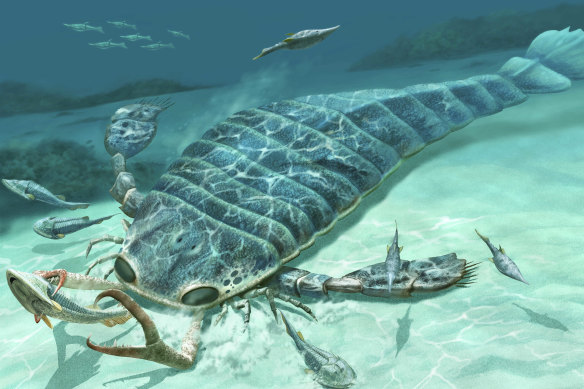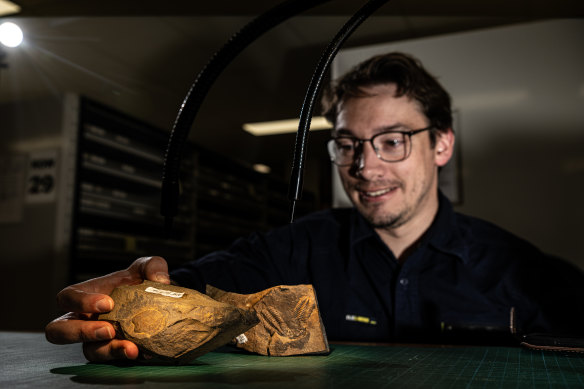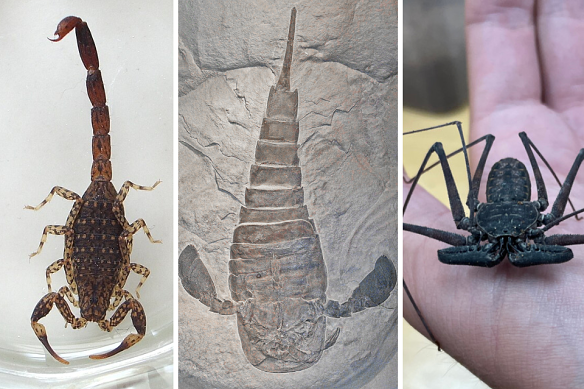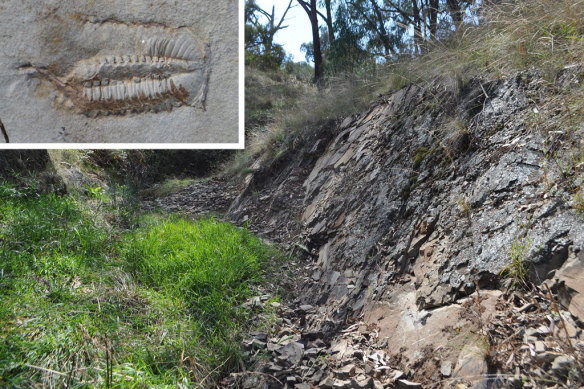- Exclusive
- National
- NSW
- Palaeontology
This was published 10 months ago
Giant ‘sea scorpions’ hunted Australian waters like sharks
By Angus Dalton
If Dr Patrick Smith hadn’t been recovering from a stroke that curtailed his movement and shrank his peripheral vision, he might not have sat for quite as long by a creek west of Orange, NSW, peering with narrowed gaze at an array of palm-sized trilobite fossils exposed in a shale wall by the gush of water.
He mightn’t have spied the curious blob within the rock – a heart-shaped oddity nestled amid the trilobites.

An artist’s impression of a species of Jaekelopterus, the largest type of sea scorpion that dominated ancient oceans as the apex predator like modern-day sharks.Credit: Ja Chirinos, Courtesy of Australian Museum
And he wouldn’t have discovered a new species of sea scorpion that once ruled the ancient oceans as crocodile-sized apex predators, snatching up primitive fish with sharp, spindly pincers and dominating whichever habitat they stalked long before reptiles or mammals even wriggled into existence.
The fossil in the rock wall turned out to be one of the creature’s underside plates. Based on that find and another specimen found further west near Cobar, Smith, a palaeontologist at the Australian Museum, has published a paper in Gondwana Research confirming the largest sea scorpions lurked in the oceans and estuaries of the supercontinent Gondwana.
The two NSW sea scorpion or “eurypterid” fossils, which are in the order of 400 million years old, shed new light on how these fearsome creatures reigned in the Paleozoic era.

Dr Patrick Smith of the Australian Museum with a fossil – roughly 400 million years old – of an ancient sea scorpion found in NSW.Credit: Nick Moir
“They probably were the top predator in almost all ecosystems they lived in,” Smith said. “They would have been one of the biggest animals, if not the biggest, at the time.”
The top of the food chain is an unusual place for an arthropod. Modern-day arthropods include beetles, spiders, slaters, crabs and bees; creatures we mostly think of as prey rather than apex predators.
But the fossils show the scorpions may have traversed vast prehistoric oceans to the realms of Gondwana that became Australia, a feat Smith’s colleague at the American Museum of Natural History, Russell Bicknell, said is “absolutely pushing the limits of what we know arthropods could do”.
“They were effectively functioning as sharks,” Bicknell told The New York Times.
The kind of sea scorpions in Smith’s study, the pterygotids, had long, powerful, segmented bodies like modern-day scorpions, but rather than a curling stinger, they had a large, flat paddle for swimming.

Eurypterids had a similar segmented body to modern-day scorpions (pictured left is a 2.5 centimetre marbled scorpion from NSW) and some had slender pincers comparable to those of a whip scorpion (right).Credit: Wikimedia
The four-eyed hunters had slender pincers, like today’s whip-scorpions, which they probably used to grab the soft tails of prehistoric fish.
The species found near Orange grew to about 1.7 metres and may have lived 100 metres below ocean waves, while the kind found near Cobar inhabited swamps and was the largest arthropod that ever lived: the 2.5 metre monster Jaekelopterus.
A local fossil club took Smith out to the shale site in 2022. He couldn’t drive as he recovered from a stroke earlier that year – an event he credits with helping him find the fossil.

The rocky outcrop of the Wallace Shale, where Smith discovered one of the sea scorpion fragments among trilobite fossils.Credit: Dr Patrick Smith, Australian Museum
“I couldn’t move very far. I didn’t have a lot of energy. So I sat down next to this stream and just sifted through large volumes of rock,” he said.
“I was able to find it much more easily, I suspect, than if I’d been wandering around with a lot of energy like I have now or back before my stroke. I think it was partly responsible for me finding it.”
Now the race is on to find more evidence of the sea scorpions.
“Eurypterid fragments are potentially common within NSW and need to be collected to be fully described and understood. We need to understand the diversity of these guys in Australia to properly understand their evolutionary history.”
The Examine newsletter explains and analyses science with a rigorous focus on the evidence. Sign up to get it each week.